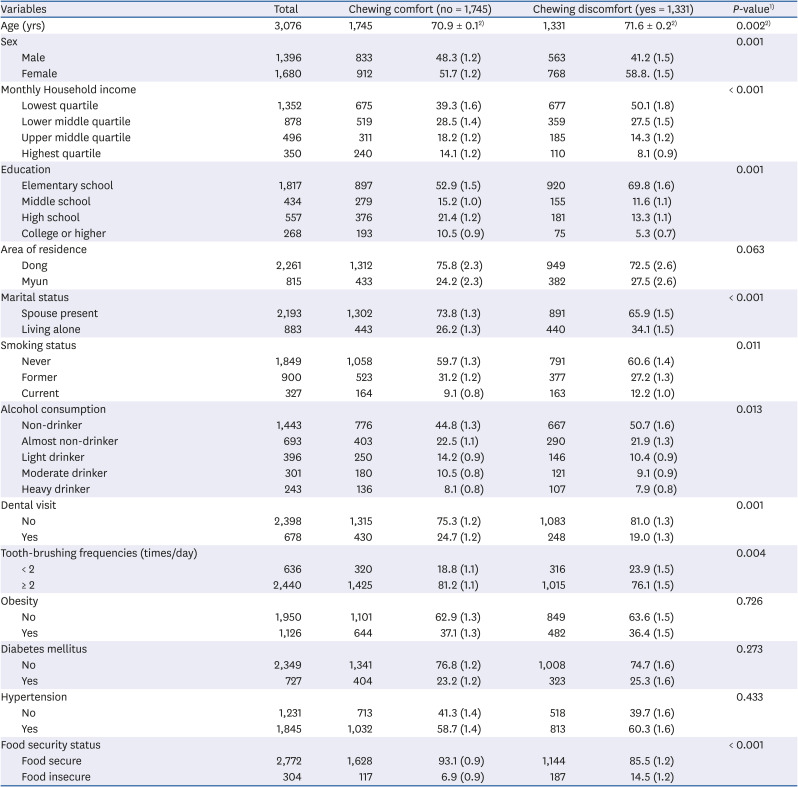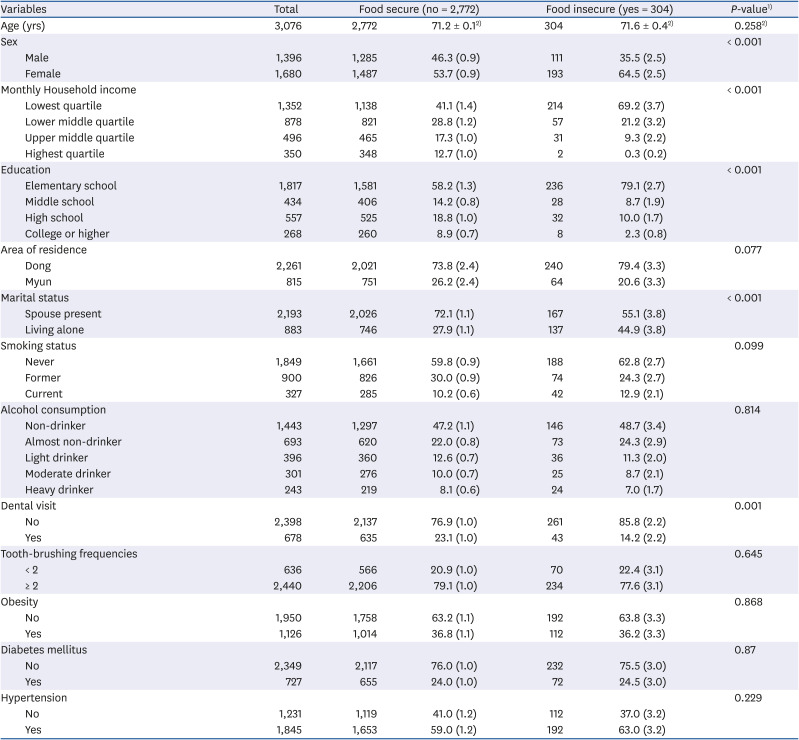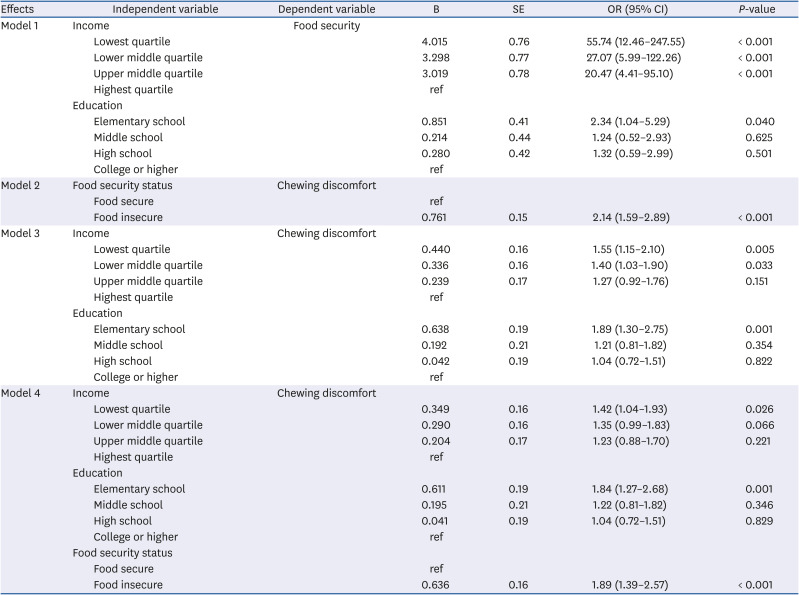1. Di Cesare M, Khang YH, Asaria P, Blakely T, Cowan MJ, Farzadfar F, Guerrero R, Ikeda N, Kyobutungi C, Msyamboza KP, et al. Inequalities in non-communicable diseases and effective responses. Lancet. 2013; 381:585–597. PMID:
23410608.

2. Pillay-van Wyk V, Bradshaw D. Mortality and socioeconomic status: the vicious cycle between poverty and ill health. Lancet Glob Health. 2017; 5:e851–e852. PMID:
28807172.

3. Tsakos G, Demakakos P, Breeze E, Watt RG. Social gradients in oral health in older adults: findings from the English longitudinal survey of aging. Am J Public Health. 2011; 101:1892–1899. PMID:
21852627.

4. Guarnizo-Herreño CC, Watt RG, Fuller E, Steele JG, Shen J, Morris S, Wildman J, Tsakos G. Socioeconomic position and subjective oral health: findings for the adult population in England, Wales and Northern Ireland. BMC Public Health. 2014; 14:827. PMID:
25107286.

5. Tsakos G, Sheiham A, Iliffe S, Kharicha K, Harari D, Swift CG, Gillman G, Stuck AE. The impact of educational level on oral health-related quality of life in older people in London. Eur J Oral Sci. 2009; 117:286–292. PMID:
19583757.

6. Steele J, Shen J, Tsakos G, Fuller E, Morris S, Watt R, Guarnizo-Herreño C, Wildman J. The Interplay between socioeconomic inequalities and clinical oral health. J Dent Res. 2015; 94:19–26. PMID:
25344336.

7. Han DH, Khang YH. Lifecourse socioeconomic position indicators and tooth loss in Korean adults. Community Dent Oral Epidemiol. 2017; 45:74–83. PMID:
27726172.

8. Listl S, Watt RG, Tsakos G. Early life conditions, adverse life events, and chewing ability at middle and later adulthood. Am J Public Health. 2014; 104:e55–e61.

9. Korea Centers for Disease Control and Prevention. Korea Health Statistics 2015: Korea National Health and Nutrition Examination Survey (KNHANES). Cheongju: Korea Centers for Disease Control and Prevention;2015.
10. Shin HS, Ahn YS, Lim DS. Association between chewing difficulty and symptoms of depression in adults: results from the Korea National Health and Nutrition Examination Survey. J Am Geriatr Soc. 2016; 64:e270–e278. PMID:
27874179.

11. Park HS, Suh HC, Kim HS, Kim DK, Lee SY. Validation of questionnaire for chewing and swallowing function of the elderly. J Korean Dysphagia Soc. 2017; 7:25–34.
12. Park JH, Kwon HK, Kim BI, Choi CH, Choi YH. A survey on the oral health condition of institutionalized elderly people resident in free asylum. J Korean Acad Dent Health. 2002; 26:555–566.
13. Han G, Yang E. Evaluation of dietary habit and nutritional intake of Korean elderly: data from Korea National Health and Nutrition Examination Survey 2013–2015. J East Asian Soc Diet Life. 2018; 28:258–271.

14. Food and Agriculture Organization of the United Nations. The State of Food Insecurity in the World 2001. Rome: Food and Agriculture Organization of the United Nations;2002.
15. Carter MA, Dubois L, Tremblay MS, Taljaard M. Local social environmental factors are associated with household food insecurity in a longitudinal study of children. BMC Public Health. 2012; 12:1038. PMID:
23190743.

16. Vozoris NT, Tarasuk VS. Household food insufficiency is associated with poorer health. J Nutr. 2003; 133:120–126. PMID:
12514278.

17. Klesges LM, Pahor M, Shorr RI, Wan JY, Williamson JD, Guralnik JM. Financial difficulty in acquiring food among elderly disabled women: results from the Women's Health and Aging Study. Am J Public Health. 2001; 91:68–75. PMID:
11189828.

18. Kim HJ, Oh K. Household food insecurity and dietary intake in Korea: results from the 2012 Korea National Health and Nutrition Examination Survey. Public Health Nutr. 2015; 18:3317–3325. PMID:
25828606.

19. Kwon SO, Oh SY. Associations of household food insecurity with socioeconomic measures, health status and nutrient Intake in low income elderly. J Nutr Health. 2007; 40:762–768.
20. Lee JY. The role of household food security on diet and health: Korean National Health and Nutrition Examination Survey (KNHANES) 2013–2015 [master's thesis]. Seoul: Kyung Hee University;2018.
21. Yang YJ. Socio-demographic characteristics, nutrient intakes and mental health status of older Korean adults depending on household food security: based on the 2008–2010 Korea National Health and Nutrition Examination Survey. Korean J Community Nutr. 2015; 20:30–40.

22. Muirhead V, Quiñonez C, Figueiredo R, Locker D. Oral health disparities and food insecurity in working poor Canadians. Community Dent Oral Epidemiol. 2009; 37:294–304. PMID:
19515196.

23. Chi DL, Masterson EE, Carle AC, Mancl LA, Coldwell SE. Socioeconomic status, food security, and dental caries in US children: mediation analyses of data from the National Health and Nutrition Examination Survey, 2007–2008. Am J Public Health. 2014; 104:860–864. PMID:
24625141.

24. Frazão P, Benicio MH, Narvai PC, Cardoso MA. Food insecurity and dental caries in schoolchildren: a cross-sectional survey in the western Brazilian Amazon. Eur J Oral Sci. 2014; 122:210–215. PMID:
24754799.

25. Kweon S, Kim Y, Jang MJ, Kim Y, Kim K, Choi S, Chun C, Khang YH, Oh K. Data resource profile: the Korea National Health and Nutrition Examination Survey (KNHANES). Int J Epidemiol. 2014; 43:69–77. PMID:
24585853.

26. Korea Centers for Disease Control and Prevention. Guidelines for the Use of Korea national Health and Nutrition Examination Survey 2013–2015. Cheongju: Korea Centers for Disease Control and Prevention;2015.
27. Kim KR, Hong SA, Kwon SO, Choi BY, Kim GY, Oh SY. Validation of food security measures for the Korean National Health and Nutrition Examination Survey. Korean J Community Nutr. 2011; 16:771–781.

28. Elani HW, Harper S, Allison PJ, Bedos C, Kaufman JS. Socio-economic inequalities and oral health in Canada and the United States. J Dent Res. 2012; 91:865–870. PMID:
22837551.

29. Ravaghi V, Quiñonez C, Allison PJ. The magnitude of oral health inequalities in Canada: findings of the Canadian health measures survey. Community Dent Oral Epidemiol. 2013; 41:490–498. PMID:
23383978.

30. Galobardes B, Shaw M, Lawlor DA, Lynch JW, Davey Smith G. Indicators of socioeconomic position (part 1). J Epidemiol Community Health. 2006; 60:7–12.

31. Turrell G, Sanders AE, Slade GD, Spencer AJ, Marcenes W. The independent contribution of neighborhood disadvantage and individual-level socioeconomic position to self-reported oral health: a multilevel analysis. Community Dent Oral Epidemiol. 2007; 35:195–206. PMID:
17518966.

32. Di Bernardi ER, Tsakos G, Sheiham A, Peres KG, Peres MA. Association of changes in income with self-rated oral health and chewing difficulties in adults in Southern Brazil. Community Dent Oral Epidemiol. 2016; 44:450–457. PMID:
27112581.

33. Gundersen C, Ziliak JP. Food insecurity and health outcomes. Health Aff (Millwood). 2015; 34:1830–1839. PMID:
26526240.

34. Pérez-Escamilla R, Segall-Corrêa AM, Kurdian Maranha L, Sampaio Md Mde F, Marín-León L, Panigassi G. An adapted version of the U.S. Department of Agriculture Food Insecurity module is a valid tool for assessing household food insecurity in Campinas, Brazil. J Nutr. 2004; 134:1923–1928. PMID:
15284377.
35. Seligman HK, Laraia BA, Kushel MB. Food insecurity is associated with chronic disease among low-income NHANES participants. J Nutr. 2010; 140:304–310. PMID:
20032485.

36. Zhang L, Curhan GC, Forman JP. Diet-dependent net acid load and risk of incident hypertension in United States women. Hypertension. 2009; 54:751–755. PMID:
19667248.

37. Alhazmi A, Stojanovski E, McEvoy M, Garg ML. The association between dietary patterns and type 2 diabetes: a systematic review and meta-analysis of cohort studies. J Hum Nutr Diet. 2014; 27:251–260. PMID:
24102939.

38. Shariff ZM, Khor GL. Obesity and household food insecurity: evidence from a sample of rural households in Malaysia. Eur J Clin Nutr. 2005; 59:1049–1058. PMID:
16015271.

39. Banerjee T, Crews DC, Wesson DE, Dharmarajan S, Saran R, Ríos Burrows N, Saydah S, Powe NR, Powe NR, Banerjee T, et al. Food insecurity, CKD, and subsequent ESRD in US adults. Am J Kidney Dis. 2017; 70:38–47. PMID:
28215947.

40. Hujoel PP, Lingström P. Nutrition, dental caries and periodontal disease: a narrative review. J Clin Periodontol. 2017; 44(Suppl 18):S79–S84. PMID:
28266117.

41. Chapple IL, Bouchard P, Cagetti MG, Campus G, Carra MC, Cocco F, Nibali L, Hujoel P, Laine ML, Lingstrom P, et al. Interaction of lifestyle, behaviour or systemic diseases with dental caries and periodontal diseases: consensus report of group 2 of the joint EFP/ORCA workshop on the boundaries between caries and periodontal diseases. J Clin Periodontol. 2017; 44(Suppl 18):S39–S51. PMID:
28266114.

42. Hujoel P. Dietary carbohydrates and dental-systemic diseases. J Dent Res. 2009; 88:490–502. PMID:
19587153.

43. Locker D. Changes in chewing ability with ageing: a 7-year study of older adults. J Oral Rehabil. 2002; 29:1021–1029. PMID:
12453254.

44. Kim HR, Kawk NS, Kim ES, Jo YY. Improving national diet by promoting the nutrition management of institutional foodservice. Sejong: Korea Institute for Health and Social Affairs;2010.







 PDF
PDF Citation
Citation Print
Print



 XML Download
XML Download